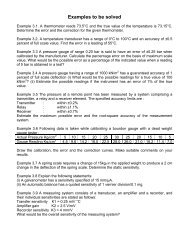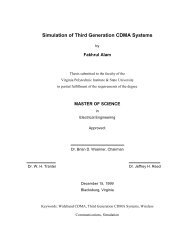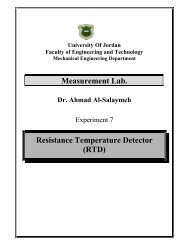Communications I Dr. Mohammed Hawa Introduction to Digital - FET
Communications I Dr. Mohammed Hawa Introduction to Digital - FET
Communications I Dr. Mohammed Hawa Introduction to Digital - FET
You also want an ePaper? Increase the reach of your titles
YUMPU automatically turns print PDFs into web optimized ePapers that Google loves.
An example of using the raised-cosine pulse combined with polar line code is shownin Figure 28, where the binary sequence „1011011100‟ is transmitted. Notice that weuse p(t) for logic 1 and -p(t) for logic 0 (i.e., the polar line code). The dotted linesrepresent the raised-cosine pulses p(t) and -p(t) corresponding <strong>to</strong> individual bits,while the solid line represents the result of adding these pulses (i.e., the transmittedsignal on the channel). At the receiver side, sampling the received signal at exactlythe middle of the bit time will retrieve the original bit sequence as shown in theFigure.Our example used raised-cosine pulses with parameter = 0.5. In such case, thebandwidth of the resulting stream is given by the formula (1+) f0 / 2 = (1+0.5) f0 / 2= 0.75 f0, where f0 is the data rate. Hence, if f0 = 50 kbit/s, the resulting bandwidth =37.5 kHz. What would the bandwidth have been if you used a rectangular NRZpulse? How about a rectangular RZ pulse?ClockData 1 0 1 1 0 1 1 1 0 01 V0-1 VTXsignal1 V-1 V1 VRXsampling-1 VFigure 28.20
















